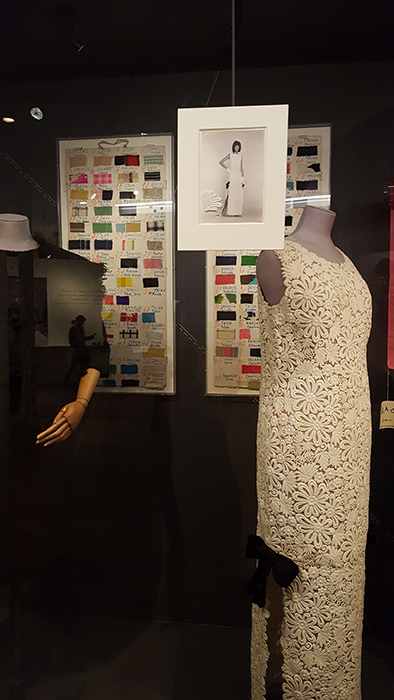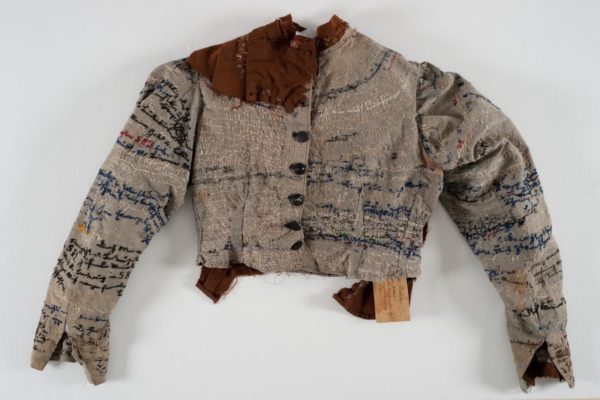In the Maurice Verbaet Center in Antwerp there currently hangs Sven’t Jolle’s ‘Yves Saint-Lazare’ (2014): a large piece of brown cloth draped over a metal clothes hanger. It could be a shift dress, but it is tattered and dirty, and there are three large holes ripped in the fabric. It is actually an old rag from the artist’s studio, repurposed for display as an art object itself and originally created for exhibition in a Parisian gallery, located on the Rue du Grenier-Saint-Lazare, during fashion week. Textile art takes on the guise of fashion and fashion, sculpture and textiles come together in a piece that comments on art as a luxury good.

Jolle’s work appears as part of Soft? Tactile Dialogues, the first exhibition by Antwerp’s ModeMuseum to shift its focus from fashion to textile art. The show is inspired by a collection of textile works by Belgian artists that had, until now, remained hidden in the museum’s archives. To celebrate the work of their creators, curator and Courtauld alumna Elisa de Wyngaert has sought to unearth these pieces and give them the attention that they certainly deserve.

The first half of the show contains a selection of these archival pieces, produced by female artists from the ‘Textielgroep’ movement in the 1960s and 1970s. A number of large-scale works dominate, including Tapta’s twisted woven lengths and Liberta Ferket’s ‘Treurend vangnet’, its long knots of plaited rope falling heavily from the ceiling. Behind these hangs Veerle Dupoint’s ‘Alruin’, its earthy tones matched by the extraordinary musty odour that emanates from it. Historically associated with female artists, textile was embraced by these women to explore and advance the creative potential of the medium. These works are not delicate or pretty. Their appeal comes from their strength, their weighty materiality, rough textures, nubby woven surfaces, and frayed tufts. It is their tactility that seduces.

The second half of the show takes place in the adjacent stairwell and is dedicated to works by contemporary female and male Belgian artists. This unusual space is used to its advantage by de Wyngaert in an exploration of the various ways in which textile art has developed. Works include Klaas Rommelaere’s tapestries, made in collaboration with a group of local ‘grandmothers’ and Wiesi Will’s colourful installation of fine knit hangings. These artists embrace vibrant colours and a range of different media, from fabric to plastic and glass.

In both halves of the exhibition, the works come into their own when they interact with one another. When you stand at the entrance of the first room and catch a glimpse of the coarse surface of Dupoint’s work through the gaps in Tapta’s sculptural forms, the tactile qualities of the different materials and techniques communicate across the space. Similarly, the staircase provides a unique location in which the works frame and refract off one another, inviting the viewer to engage with the exciting possibilities offered by textile art.

If anyone needed persuading that a fashion museum should widen its scope to include textile art, this exhibition provides more than enough reason. It is notable that a number of the contemporary artists that are included have worked in or studied fashion. Christoph Hefti studied at Central Saint Martins and was a print developer at Dries Van Noten, Klaas Rommelaere interned at Henrik Vibsov and Raf Simons, and Laure Van Brempt and Vera Roggli, of Weisi Will, worked as designers at Christian Wijnants. Both fashion and textile art activate and explore the expressive capacity of fabric and, as the work of these artists demonstrates, there is much to be gained from recognising the dynamic that exists between the two.

Catch the exhibition from 28-09-18 to 24-02-19 at the Maurice Verbaet Center in Antwerp. There are also a number of associated events taking place around the city. Visit https://www.momu.be/en/exhibitions/soft-tactiele-dialogen for more information.




